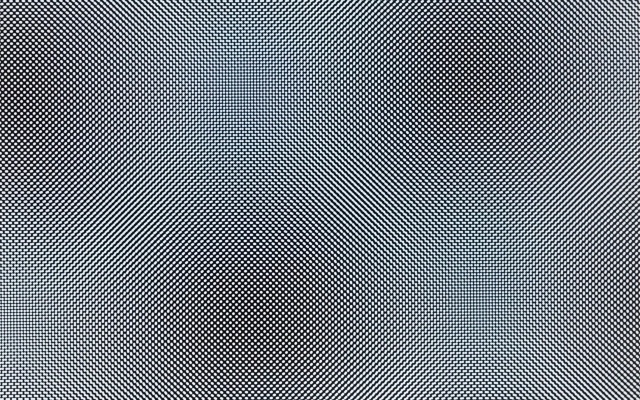“Shall I now continue this soliloquy, or shall I imagine an audience, which will make me describe?”
– Virginia Woolf, from her diary, 12 August 1928
First, there was Earth, Water, Fire, and Air: then, solid, liquid, gas, plasma. Now, all everyday material is composed of atoms, and there are electrons, protons, photons. The elements have always been there. Scientists find and discard, reject or reconsider, shift their attitudes in tune with discoveries, add and subtract. They keep devising and adjusting their sights. They change ideas, when able to imagine what might be more true about the universe, or valid, and, by observing and experimenting, they come to understand what they see, what they believe is there. Not so different from art, from her point of view.
“All this criticism however may well be dislodged by the desire to write a story.”
You could say, “Elementary, my dear Watson.” You could say it, but you’d have to be kidding. First of all, Holmes never said it, but everyone thinks he did. He never said it. Does it matter? And, I’m not Watson. And Holmes didn’t exist. He could have been based on an actual detective, but Arthur Conan Doyle created him out of thin air. Look how many movies and TV shows come from those stories, lately more and more. People want the real thing, whatever that is, and some want it “based on a true story.” But even if it is based on an actual event, even if it’s a fact, so-called, why did it happen in the first place, or why did someone do it, she wondered. That’s where the story is, in the interpretation.
He wanted to be visited by a miracle, not visit old churches in Italy or France. He had his fantasies, and kept writing stories. Maybe he’d do something no one else ever had, and if it happened ... would he recognize the miraculous. Maybe he’d feel differently, and see what he couldn’t before. Otherwise, sightseeing felt like sightless seeing, no disrespect meant to the sightless, they saw in other ways. 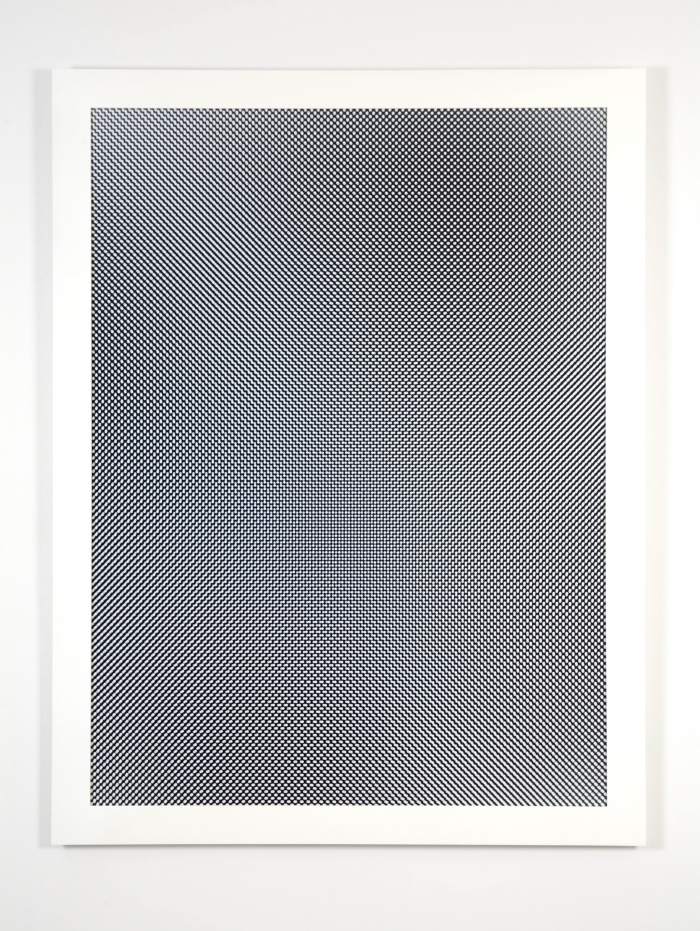
"Moiré #2", 2007. Wydruk chromogeniczny. 54 x 40 cali (137.2 x 101.6 cm). Rama: 60 x 46 cali (152.4 x 116.8 cm). Dzięki uprzejmości Liz Deschenes i Miguel Abreu Gallery, Nowy Jork. Zdjęcie: John Berens.
“We had tea from the bright blue cups under the pink light of the giant hollyhock.”
In a spacious room, he came upon a sculpture, a series of tall, standing panels—sky-walls, he called them. He wrote that down. The work might not foster that sensation in anyone else. They could be described differently.
The skies rose up from the floor, defiant. Blue, bluer, bluest, the colors mutated, darkened and lightened, became more intense or subtle. As he walked past the panels, the colors took on weight. Heavier, lighter, like his irascible moods.
“Why did my eye catch the trees?”
He noticed a flow of people, all characters to him, a writer. They were milling around. Some wore hats, others had covered their heads in brightly colored scarves. It was a cold day. People usually coped.
Most looked down at the floor, then up at the ceiling, and then they stopped, looked straight ahead. Some people stood in place for a long while. They watched light bouncing off a large, flat, shiny object. He paid attention, first, to them—people looking, always a curious thing, how we watch each other, he thought. Then he settled into himself, his eyes following a movement of light, faster than a speeding bullet. Guns were too much on his mind, even in this clean, well-lighted space.
He walked closer to the shiny object and noticed tiny patterns on it, but couldn’t decide if they were patterns or random marks that he was conjuring into patterns. Or, even if they were actually there, on the surface, or only a reflection of bouncing waves of indiscriminate light. Or, if his speculations mattered. 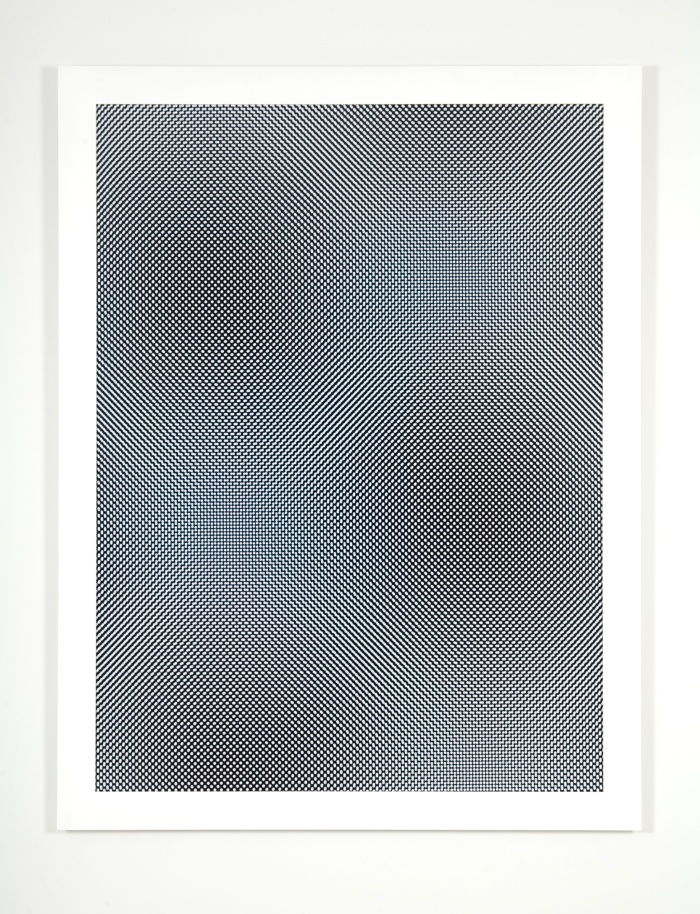
"Moiré #3", 2007. Wydruk chromogeniczny. 54 x 40 cali (137.2 x 101.6 cm). Rama: 60 x 46 cali (152.4 x 116.8 cm). Dzięki uprzejmości Liz Deschenes i Miguel Abreu Gallery, Nowy Jork. Zdjęcie: John Berens.
“The look of things has a great power over me.”
She set things up in a specific way, while also trying to be spontaneous, uncalculating, because no one could account for everything that might happen. She once told an audience that she didn’t want to scheme, or be cunning, just to let it happen. She admitted that she aimed for surprise, though she was serious about expectations, theirs, especially hers. If she wasn’t surprised, no one else would be.
Suddenly, a need gathered in her to collect her thoughts and put them in a place, or a thing. Call it a relation to objects, on paper or in space, or object relations, a sense of what should be there that wasn’t.
His reactions counted, he supposed, though they were filtered through a universe of causes, an environment he didn’t make. He should have more trust in his feelings. Reactions, responses, were confusing, complex as the words he used to describe them, like emotions.
Words themselves made images, and also made him hesitate to commit to one or the other. Sticky descriptors, which, once said, can never be unsaid. Once published, there. Until not there. Uncontrollable feelings get attached to words, for instance, “beauty.” Or, the word “soft.” And, yes, “love.”
“Even now I have to watch the rooks beating up against the wind, which is high.”
The big picture windows stretched from floor to ceiling, letting the sunlight into the capacious room. Near the windows, she placed her structures, which mimicked the windows, but didn’t let light through, or the outside in. The differences between inside and outside, even artificial and natural light, suggested a kind of paralleling. Not imitation, because she wasn’t trying to remake the natural world, which seemed less natural every second, but to suggest a relationship between them, ways of seeing them. People looked one way at a photograph on a wall or in an album, and another way at a plane or bird flying in the sky, fit them into categories. Maybe she could unmake some. That might be a miracle. 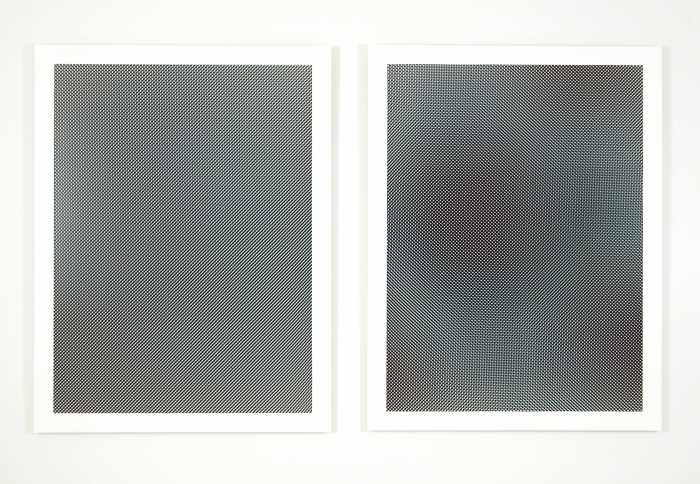
"Moiré" #6 oraz #7 (dyptyk), 2007. Wydruk chromogeniczny. Wymiary pojedynczego wydruku: 60 x 46 cali (152.4 x 116.8 cm), łącznie: 60 x 98 cali. Dzięki uprzejmości Liz Deschenes i Miguel Abreu Gallery, Nowy Jork. Zdjęcie: John Berens.
“. . . and still say to myself instinctively, ‘What’s the phrase for that?’”
In another country, another language. Anyway, truisms get spoken everywhere, convenient turns of phrase fill spaces where active thinking doesn’t happen. If he was persistent, he’d figure out what was necessary for him to know. Get down to basics, as peculiar as that sounded now, when “basic” included way too much for way too few, way too little for the many—the many too many.
He’d cut away the flab, and put his writing on a diet. Ha. But those usually didn’t work. Materialism creates an obesity of wants, and who can get any satisfaction. But what was he looking for, anyway. A friend had told him that if he didn’t look for it, he might find it. That was way too mystical for him.
“ ... the tremor of the rook’s wing slicing as if the air were full of ridges and ripples and roughnesses.”
Expectations are habits, the psyche’s demands, like hopes, and, even more abstractly, there are habits about the visible world, what people expect to see—and how they describe it to themselves.
Artists have habits, sometimes called their style, approach, attitude, influences.
Nuns wears habits, or used to. In her mind’s eye, a nun stood near the school door, and called to her, Hurry up. She was late for class.
She wore art every day, put it on, thought about it, even without wanting to, it seemed always to be with her, she attended to the same and different questions, same and different answers, new, old, new in old, old in new. She had to be in time, she couldn’t be late to class now.
“They rise and sink.”
Now you see it, now you don’t. No one sees “the same,” though it’s hard to absorb the vastness of variation between people, and in the world—perception is a tricky beast. 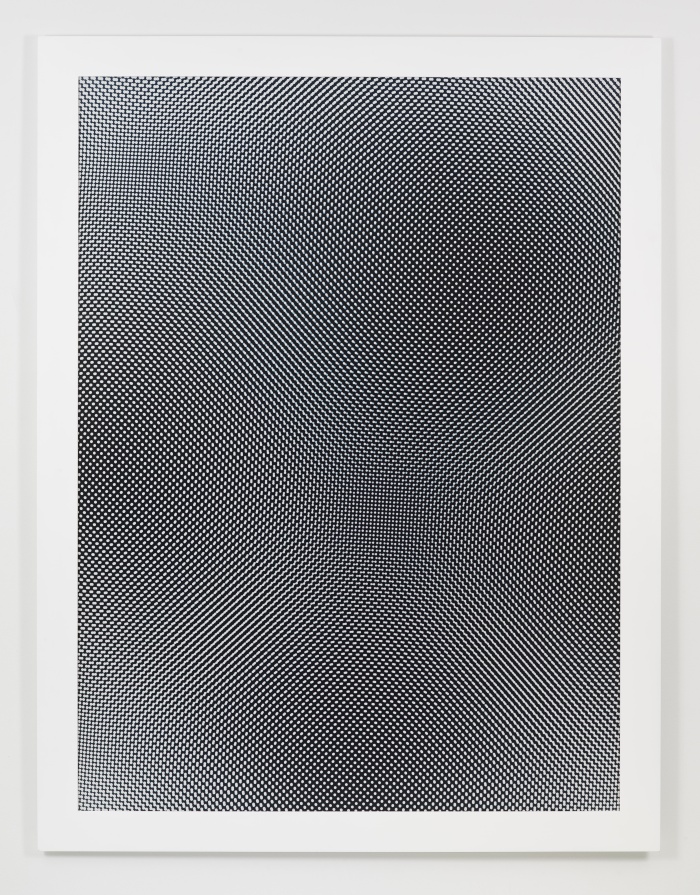
"Moire #25", 2009. Wydruk chromogeniczny. 54 x 40 cali (137.2 x 101.6 cm). Rama: 60 x 46 cali (152.4 x 116.8 cm). Dzięki uprzejmości Liz Deschenes i Miguel Abreu Gallery, Nowy Jork. Zdjęcie: Jeffrey Sturges.
You apprehend it, then feel apprehension. Or, the way the dictionary has it: knowing “by means of the senses of the mind” or “by your faculty of perceiving.” Literally, “to take in.” That’s the thing, to be able to take it in. Receiving is part of perceiving.
A mind has senses. (Take that in.) Though it doesn’t exist physically, but figuratively roams the body, like an abstraction, a sensibility. A mind employs all the body’s senses, where she believed her work, in part, was situated.
Agreement in standards, and values, requires a consensus from those who perceive, critics, for one, as well as viewers. In her field, consensus was always an argument.
“But what a little I can get down into my pen of what is so vivid to my eyes, and not only to my eyes; also to some nervous fibre, or fan-like membrane in my species.”
Picasso said, “The purpose of art is washing the dust of daily life off our souls.” That’s romantic, icky, she thought, but maybe it gave Picasso comfort. Consoling to believe in the soul. Beckett said: “All art is the same, to fill an empty space.” Maybe. No soul for him.
Art occupied her time, it was full, if she could put it like that, and she didn’t know where it could come from, or what would come from it, or to her.
Accidents kept coming, unplanned moments or events, and they made her day, even though she had a schedule. Today I will do this, tomorrow that ...
“The best laid plans of mice and men ... ” John Steinbeck’s Of Mice and Men, right, she’d read it in high school, but forgotten about it, that sad dust-bowl novel. But it was still somewhere in her mind.
The dust of daily life settles over everything ...
Fills empty spaces ...
Elementary ...
September 2015
BIO
Lynne Tillman writes novels, short stories, and nonfiction. Her novel No Lease On Life was a Finalist for a National Book Critics Circle Award (1998), and her essay collection What Would Lynne Tillman Do? was a Finalist for the National Book Critics Circle Award in Criticism. Her most recent collection, The Complete Madame Realism and Other Stories (2016) was published by Semiotext(e). Her sixth novel, Men and Apparitions, was published this year (2018) by Soft Skull Press. Tillman’s stories have been anthologised widely and published in, for example: Black Clock, Ploughshares, The Show I’ll Never Forget, The Milan Review, and Bomb. They also appear frequently in artists’ books and museum catalogues, including, most recently, those of Raymond Pettibon, Joan Jonas, Cindy Sherman, and Carroll Dunham. She is a columnist for Frieze art magazine. Tillman is a recipient of a Guggenheim Fellowship, a Creative Capital/Warhol Foundation grant for arts writing, and is a Professor/Writer in Residence at The University at Albany. She also teaches in New York City’s School of Visual Arts, in its Art Criticism and Writing MFA Program. She lives in Manhattan with bass player David Hofstra.
* Cover photo: Moiré #3, 2007. UV laminated chromogenic print. 54 x 40 inches (137.2 x 101.6 cm). Framed: 60 x 46 inches (152.4 x 116.8 cm). Courtesy Liz Deschenes and Miguel Abreu Gallery, New York. Photo: John Berens.
Note: All quotes, unless otherwise specified, are from Leonard Woolf, ed., A Writer’s Diary: Being Extracts from the Diary of Virginia Woolf (New York: Harcourt, Brace and Company, 1954), 128.



